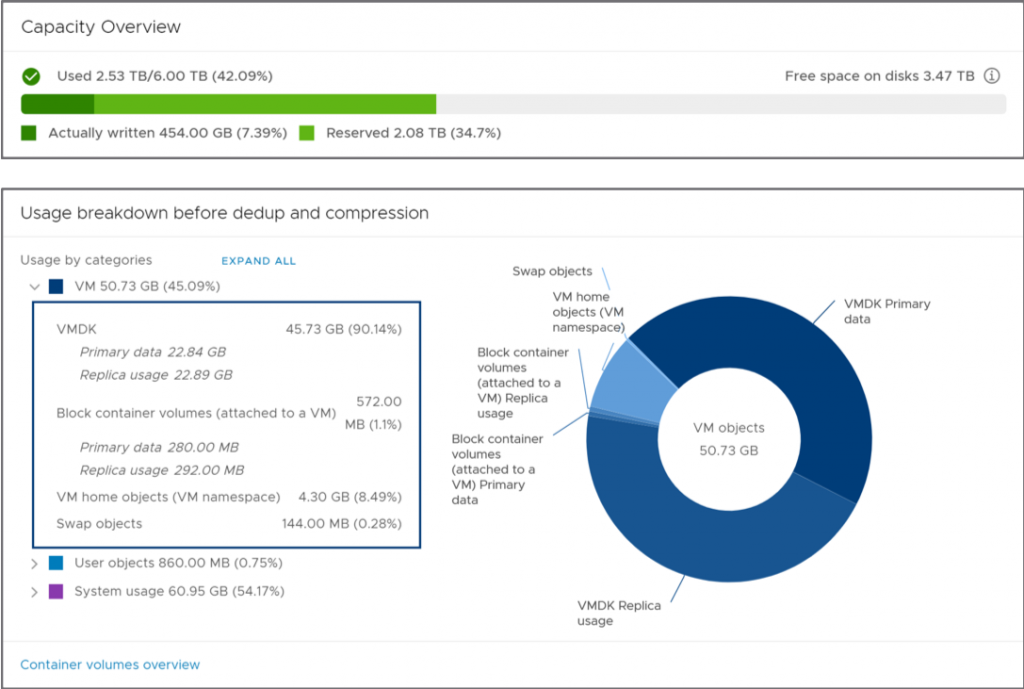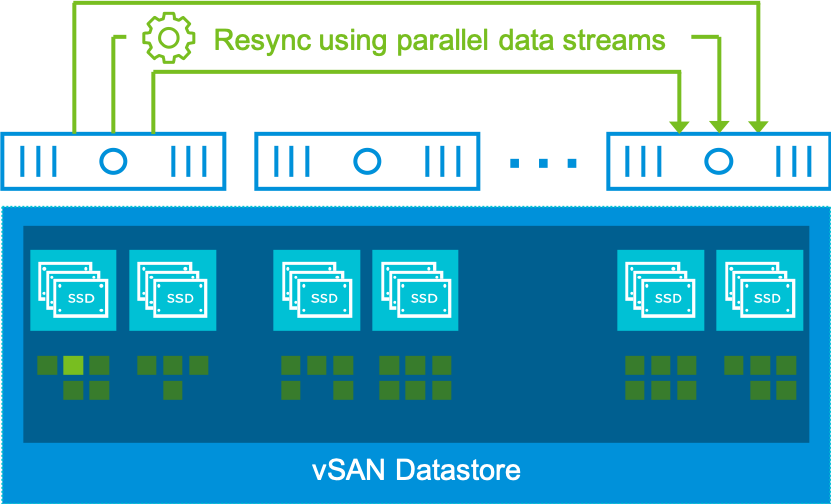VMware vSAN continues to be the Hyperconverged Infrastructure (HCI) market leader. vSAN has proven to be a great fit for all types of workloads, with over 20,000 customers. Traditional applications like Microsoft SQL Server and SAP HANA; next-generation applications like Cassandra, Splunk, and MongoDB; and even container-based services orchestrated through Kubernetes are run on vSAN by customers today. The success of vSAN can be attributed to many factors such as performance, flexibility, ease of use, robustness, and pace of innovation.
Paradigms associated with traditional infrastructure deployment, operations, and maintenance include using various disaggregated tools and often specialized skillsets. The hyperconverged approach of vSphere and vSAN simplifies these tasks using familiar tools to deploy, operate, and manage private-cloud infrastructure.
VMware continues to innovate and enhance vSAN, resulting in additional features, better efficiency, and streamlined management in vSAN 6.7 Update 3. vSAN has a lot in store for those new to hyperconverged infrastructure, as well as some very compelling reasons to upgrade existing vSAN environments.
Unified Management for today and tomorrow’s applications
VMware vSAN already does a great job of virtual machine data management for traditional applications. Virtual machine data is managed by storage policy to meet the performance and protection characteristics required by the application.
What about container-based workloads? The popularity of container-based workloads changes the traditional delivery of applications through the use of container orchestration with Kubernetes (K8s).
vSAN 6.7 U3 brings tight integration with Kubernetes through the use of a Container Storage Interface (CSI) driver for vSphere. Persistent volumes used by these applications can be easily managed by a vSphere administrator, just as easily as managing a virtual machine’s virtual disks.
vSphere administrators manage a volume, or “first-class” disk (FCD), characteristics to ensure it meets the performance and protection requirements needed by the application.
A single UI keeps management simple, even when vSAN is used by multiple orchestration platforms. Persistent volumes are enumerated just as virtual machine objects are, with the ability to filter based on K8s metadata.
By treating persistent volumes as first-class citizens, vSAN administrators can easily manage them in the same fashion they are already familiar with for virtual machines.
Check out the Introducing Cloud Native Storage for vSphere blog post for more information on using vSAN 6.7 Update 3 for Cloud Native Storage.
Intelligent Operations for Simplicity & Consistency
vSAN 6.7 U3 improves upon the tools used to operate and manage vSAN.
It is essential to understand capacity management to properly administer any storage system. vSAN has made some enhancements to help vSAN administrators better handle the task of capacity management.
- Simplified capacity usage with color-coding, consumption breakdown, and usable capacity analysis for better capacity planning allows administrators to more easily understand the consumption breakdown.

- Capacity handling is improved to allow resyncs depending on the available capacity. In cases where a disk group could become full, resyncs are paused to prevent any VM I/O disruption.
- Administrators can choose to automate the process of rebalancing data across the cluster. With each customer’s data being unique, the ability to configure a custom rebalancing variance, addresses a more uniform distribution of data across the cluster.
- Policy changes now occur in batches. This ensures that all policy changes complete successfully, and free capacity is not exhausted.
- Performing maintenance or configuration changes while resyncs are occurring could prevent resyncs from completing properly. In vSAN 6.7 U3, the vSphere Client now provides a better understanding of how long resyncs from storage policy changes, data rebalancing, and/or some type of failure are going to take to complete.
In addition to capacity management, it is important to understand ongoing and potential operations. vSAN 6.7 U3 provides some pretty significant enhancements to give administrators more choice and flexibility when it comes to maintenance operations, upgrades, or issue resolution.
- It is important to know how, or if maintenance operations will change the conditions of a cluster. Enhanced predictive analysis is now accomplished through a pre-check simulation, helping administrators make more informed decisions when performing maintenance operations.
- Disk format changes (DFC) are required when changing a clusters deduplication, and compression or encryption state. If sufficient resources are not available for these tasks to complete successfully, the DFC will fail. A new predictive DFC check ensures there are sufficient resources available before proceeding.
- vSAN now allows administrators the option to upgrade to the next major release or apply patches. This provides better overall platform flexibility for hardware that has not yet been validated for newer versions of vSAN, as well as when vSAN is used with other solutions that have specific vSphere version requirements.
- Previous versions of vSAN have required that vCenter be an equal or newer version than the version of vSAN being used. vSAN now supports better interoperability between versions of vCenter and ESXi. As long as vCenter is in the same release line, going forward, vSAN hosts can be upgraded without necessarily upgrading vCenter beforehand, streamlining lifecycle management just like that of non-vSAN vSphere clusters.
- It is even easier to enable vSAN Support Insight in vSAN 6.7 U3. Administrators that haven’t taken advantage of it can see it helps with faster time to resolution when troubleshooting with VMware GSS, while providing anonymized data that directly helps VMware improve vSAN.
These capacity management and operations enhancements are not the only opportunities for improvement made in vSAN 6.7 U3. From a data services perspective, vSAN 6.7 U3 adds a few more features to make the management of specific workloads easier.
- iSCSI LUNs presented from vSAN can now be resized without the need to take the volume offline, preventing application disruption.
- SCSI-3 persistent reservations (SCSI-3 PR) allow for native support for Windows Server Failover Clusters (WSFC) requiring a shared disk.
vSAN 6.7 U3 adds many features to help administrators better accomplish capacity management, ongoing cluster operations and maintenance, and data services tasks.
Enhanced Performance with Intelligent I/O Management
Management and operations are not the only areas where vSAN 6.7 U3 has improved. vSAN 6.7 U3 has again raised the bar from a performance perspective.
More predictable application performance is achieved in vSAN 6.7 U3 by destaging data from the write buffer to the capacity tier. This makes vSAN more efficient and consistent with increased throughput for sequential writes. The increased consistency in destaging operations results in a smaller deviation between high and low latency. This increased throughput also reduces the amount of time necessary for resyncs from repairs and rebuild tasks.
Resyncs are further enhanced by resyncing even more data in parallel when there are resources available. Adaptive Resync introduced in vSAN 6.7 ensures that virtual machine object I/O maintains an appropriate priority.
The increased throughput, more consistent performance, and faster resyncs are just a few examples of how the vSAN 6.7U3 delivers the best possible stability and performance.
Additional metrics are now exposed in vSAN 6.7 U3 as they relate to vSAN CPU utilization. Using tools such as vRealize Operations or a newly introduced vsantop command on each host in a vSAN 6.7 U3 cluster, it is even easier to have better visibility into how data services such as deduplication and compression or encryption relate to CPU utilization.
vSphere 6.7 Update 3
Don’t forget that vSAN is part of vSphere. There have been some significant updates to vSphere 6.7 Update 3 as well. Be certain to read all about it in the Announcing vSphere 6.7 Update 3 blog.
Summary
VMware HCI, powered by vSAN, is the cornerstone for modern datacenters whether they are on-premises or in the cloud. vSAN continues to improve performance and availability while lowering cost.
Deployment and operations across on-premises or cloud environments ensure that customers can easily manage workloads, lowering the operational cost of infrastructure locally, or in the cloud.
vSAN provides a flexible, cost-effective platform that is certified in the form of VMware ReadyLabs™ validated ReadyNodes™ or Dell EMC VxRail appliances, with the ability to easily add resources as business demands increase.
VMware continues to add new capabilities, simplify existing workflows, and enhance vSAN with each release. Whether you are a customer deploying traditional, or container-based applications, vSAN continues to innovate, enhance, and simplify deployment, operations, and management tasks as the best HCI solution today – and tomorrow.
Links
- vCenter Server 6.7 Update 3
- ESXi 6.7 Update 3
- vSAN 6.7 Update 3
This was originally posted on the VMware Virtual Blocks site: https://blogs.vmware.com/virtualblocks/2019/08/13/vsan67u3-whats-new/





